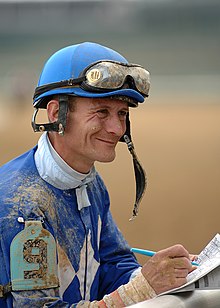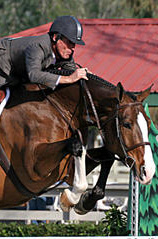Equestrian helmet
Certified helmets are required headgear for many competitive riding events, particularly where horse and rider must jump or work at high speed.
Helmets are worn more often by English-style riders and are gaining acceptance as required headgear for children and young teens.
An equestrian helmet has a hard shell on the outside of an impact-resistant resin or plastic, sometimes covered with cloth for a more attractive look.
However, the classic hunt cap, which modern helmets attempt to resemble, offered little or no protection to the rider of the horse.
The USEF also requires all junior riders (under the age of 18) in any hunt seat discipline to wear an ASTM/SEI certified helmet with harness fastened while mounted on their horse anywhere on the show grounds, and requires all riders to wear a helmet when jumping anywhere on the show grounds.
The United States Eventing Association (USEA) requires that all competitors have properly fitting headgear that is ASTM/SEI certified as well.
[7] For FEI international competition that involves competitors from many different nations, protective headgear complying with the European (EN), British (PAS), North American (ASTM), or Australian/New Zealand tested standards is required.
A newly popular style in the hunter-jumper world features a lightly textured (less shiny) plastic shell with a decorative ventilation strip down the center.
This design goes by many brand names, but, due to the ventilation strip, is informally called a "skunk helmet."
Casual riders often wear "training" or "schooling" helmets in a variety of colors and some even include patterns (such as stars or stripes).
Cloth covers in brilliant colors and vivid designs can be purchased to provide even more variety, but are frowned upon (and are sometimes illegal) in the horse show ring, where black, brown or gray are still the standard.
There are helmet designs that resemble a cowboy hat, or have other "western" styling, such as a tan color, or a cordura outer cover.
[9] Independent testing in the United Kingdom in 2003 by the British Equestrian Trade Association found a number of “traditional” designs from the three most established and respected British manufacturers failed a series of tests intended to determine if a design provided proper protection in the event of a fall.
[12] It is a performance standard written by a volunteer committee of producers (persons who represent manufacturing companies) and users of equestrian helmets, and published by ASTM International.
[11] In the United States, conformity assessment of riding helmets to defined standards is performed primarily by the Safety Equipment Institute (SEI).
[17] It defines test methods to evaluate shock absorption, penetration resistance, strength and effectiveness of retention system, durability of quick release mechanisms, and deflection of the peak.
For example, the acronym “DIN” is used to indicate the Deutsches Institut für Normung, and “BS” indicates a standard adopted in the UK.






